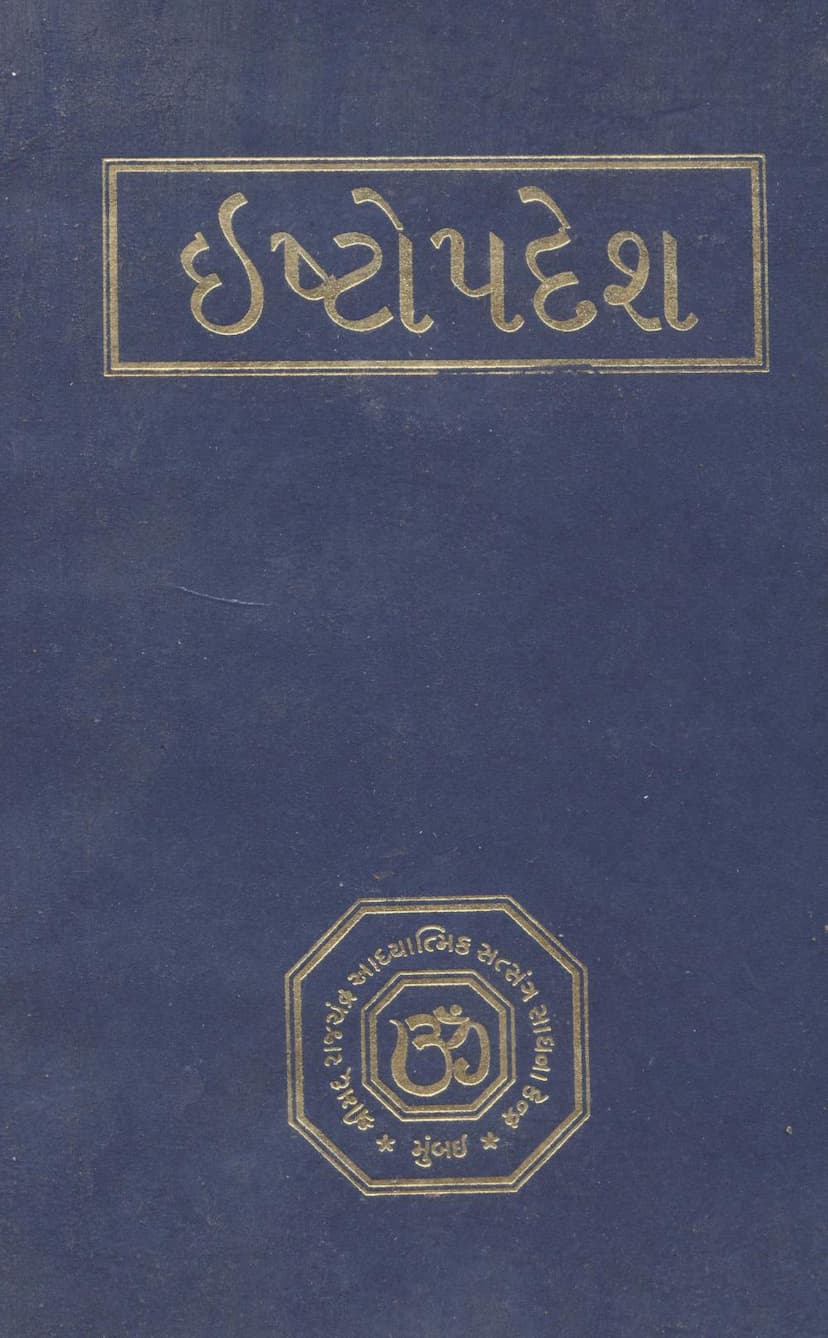Ishtopadesh
Added to library: September 1, 2025

Summary
This document is a Gujarati translation and commentary of the Jain text "Ishtopadesh" by Acharya Pujyapad Swami. The Shrimad Rajchandra Adhyatmik Satsang Sadhana Kendra, Mumbai, published this edition for personal use, coinciding with the Paryushan festival of 2002.
Here's a summary of the key themes and teachings presented in the text, based on the provided pages:
Introduction and Context:
- The publication is dedicated to the pursuit of self-welfare and spiritual liberation, inspired by the teachings of Shrimad Rajchandraji.
- It highlights the tradition of studying significant spiritual texts during Paryushan, with "Ishtopadesh" being the focus for this year.
- The introduction provides a brief biographical sketch of Acharya Pujyapad Swami, attributing his Vairagya (detachment) to witnessing a frog caught by a snake at a young age. He took Diksha (renunciation) at 15 and became an Acharya at 27. He was a scholar in various fields including grammar, logic, medicine, and poetry, and attained liberation (Moksha) through Samlekhana (controlled fasting).
- The text aims to guide individuals towards the path of self-realization and liberation.
Core Teachings of Ishtopadesh:
The text, through its verses (shlokas), expounds on several fundamental Jain philosophical concepts:
-
The Nature of the Soul and Liberation (Shlokas 1, 21, 33, 34, 45, 49, 50):
- The ultimate goal is to realize the true nature of the soul (Atma), which is pure, conscious, blissful, and eternal.
- Liberation (Moksha) is achieved when all karmas are extinguished, allowing the soul to attain its inherent self-nature.
- The soul is distinct from the body and all material substances (pudgala). This discernment between the soul and non-soul is the essence of truth.
- The soul is its own guru, guiding itself towards self-welfare through self-awareness and contemplation. External gurus are merely instrumental.
-
The Illusory Nature of Worldly Pleasures and Sorrows (Shlokas 6, 7, 8, 11, 12, 13, 14, 15, 17, 18, 19, 20, 26, 27, 28, 29, 30, 31, 32, 46):
- Worldly pleasures and pains are largely a product of desires (vasana) and ignorance (avidya).
- Attachment to the body, home, wealth, family, friends, and even enemies is based on ignorance, as these are all external and transient.
- The cycle of birth and death is a continuous chain of miseries, where one calamity is replaced by another.
- Wealth is not a true remedy for worldly suffering, as it is hard to acquire, protect, and is ultimately perishable.
- Pleasures derived from worldly pursuits are fleeting, unsatisfying, and often lead to more suffering in the long run, akin to diseases.
- The body itself is impure and the source of much suffering, making attachment to it foolish.
- Whatever benefits the body often harms the soul, and vice-versa.
- The desire for worldly possessions, even for the purpose of charity or enjoyment, is ultimately futile and leads to further entanglement.
-
The Path to Liberation:
- Detachment (Vairagya) and Renunciation: The text emphasizes the importance of detachment from worldly possessions and experiences.
- Right Conduct (Vrata): Adhering to vows (vrata) is presented as a path to celestial realms (Svarga) and ultimately liberation, whereas neglecting them leads to lower realms.
- Right Knowledge (Samyak Gyana) and Right Faith (Samyak Darshana): Understanding the true nature of the soul and reality is crucial.
- Meditation (Dhyana) and Self-Concentration (Ekagrata): Controlling the senses and focusing the mind on the soul is the primary means to achieve self-realization.
- Discernment (Bhed Gyana): The ability to differentiate between the self and the non-self is essential for spiritual progress.
- Egolessness (Nirmamatva): The state of being free from the sense of "mine" is the key to liberation, while attachment (mamata) leads to bondage.
-
The Nature of a Yogi or Enlightened Soul (Shlokas 36, 37, 38, 39, 40, 41, 42, 43, 44, 47, 48):
- A yogi cultivates a tranquil mind, free from distractions, and remains absorbed in the self.
- As self-realization deepens, worldly pleasures lose their appeal.
- The enlightened individual sees the world as an illusion (Indrajala) and yearns solely for self-attainment.
- They prefer solitude and quickly forget worldly conversations.
- Their actions and perceptions are internalized; they speak without truly "speaking," move without truly "moving," and see without truly "seeing" in the conventional sense.
- They are detached even from their own bodies, being absorbed in the divine rhythm of the self.
- This detachment leads to freedom from bondage and the attainment of eternal bliss.
- The bliss derived from self-realization burns away all karmas and renders the yogi unaffected by external sufferings.
-
The Importance of Effort and Wisdom:
- Wise individuals choose the path of self-realization over transient worldly gains.
- Continuous practice, self-effort, and adherence to the teachings are essential for spiritual progress.
- The ultimate fruit of studying texts like "Ishtopadesh" with wisdom and detachment is the attainment of equanimity and liberation.
In essence, "Ishtopadesh" is a guide for aspiring souls, encouraging them to turn inwards, understand the ephemeral nature of the material world, and dedicate themselves to the pursuit of the eternal, blissful soul.